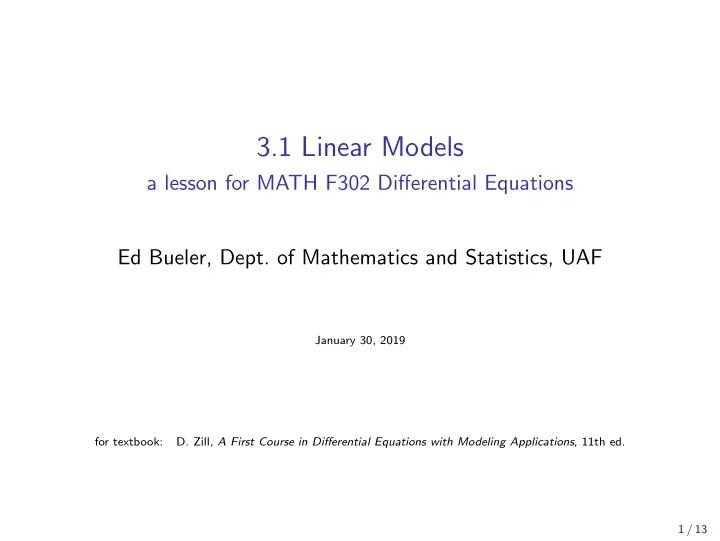

3.1 Linear Models a lesson for MATH F302 Differential Equations Ed Bueler, Dept. of Mathematics and Statistics, UAF January 30, 2019 for textbook: D. Zill, A First Course in Differential Equations with Modeling Applications , 11th ed. 1 / 13
linear models • not new material? ◦ we got a good start back in § 1.3 • this section requires ability to solve these types of DEs: 1 the easiest DE: y ′ = ky 2 separable linear equations from § 2.2: y ′ = g ( x ) y or y ′ = ay + b 3 general linear equations from § 2.3: y ′ + P ( x ) y = f ( x ) • . . . which should be easy at this point • the method in § 2.3 handles all first-order linear equations, but the other methods are usually quicker for forms or 1 2 • these slides simply contain 5 exercises from § 3.1 in this order: # 4, 42, 17, 36, 37 2 / 13
exercise 4 4. The population of bacteria in a culture grows at a rate proportional to the number of bacteria present at time t. After 3 hours it is observed that 400 bacteria are present. After 10 hours 2000 bacteria are present. What was the initial number of bacteria? 3 / 13
exercise 42 42. Fluctuating Population The differential equation dP / dt = ( k cos t ) p, where k is a positive constant, is a mathe- matical model for a population P ( t ) that undergoes yearly sea- sonal fluctuations. Solve the equation subject to P (0) = P 0 . Use a graphing utility to graph the solution for different choices of P 0 [and k]. 4 / 13
exercise 42, cont. k=0.5 k=2 k=0.5 600 400 P(t) 200 0 0 2 4 6 8 10 12 14 t 5 / 13
exercise 17 17. A thermometer reading 70 ◦ F is placed in an oven preheated to a constant temperature. Through a glass window in the oven door, an observer records that the thermometer reads 110 ◦ F after 1 2 minute and 145 ◦ F after 1 minute. How hot is the oven? 6 / 13
exercise 17, cont. 400 300 T(t) 200 100 0 0 1 2 3 4 5 6 7 t 7 / 13
exercise 36 36. How High?—No Air Resistance Suppose a small cannonball weighing 16 pounds is shot vertically upward, as shown in the Figure, with an initial velocity v 0 = 300 ft / s. The answer to “How high does the cannonball go?” depends on if we take air resistance into account. (a) Suppose air resistance is ignored. If the positive direction is upward then a model for the height s ( t ) of the cannonball is given by m d 2 s / dt 2 = − mg or equivalently d 2 s / dt 2 = − g. Since ds / dt = v ( t ) the last differential equation is the same as dv / dt = − g. We take g = 32 ft / s 2 . Find the velocity v ( t ) of the can- nonball at time t. 8 / 13
exercise 36, cont. (b) Use the result in part (a) to determine the height s ( t ) of the cannonball, measured from ground level. Find the maximum height attained by the cannonball. 9 / 13
exercise 37 37. How High?—Linear Air Resistance Repeat exercise 36, but this time assume that air resistance is proportional to instantaneous velocity. In particular, suppose that the constant of proportionality is k = 0 . 25 . 1 It stands to rea- son that the maximum height must be less than computed in exercise 36. Show this. 1 Value for k changed to make effect more obvious. 10 / 13
exercise 37, cont. 11 / 13
exercise 37, cont. cont. 300 without air resistance WITH air resistance 200 100 v(t) 0 -100 -200 0 2 4 6 8 10 12 t 12 / 13
expectations • to learn this material, just watching this video is not enough! • also: ◦ explore “found online” videos at bueler.github.io/math302/week5.html ◦ read section 3.1 in the textbook • for quizzes and exams you must be able to handle the examples like 1-6 in this section • . . . and exercises like those in WebAssign • one topic you will not be responsible for: “series circuits” and other electical examples ◦ do the WebAssign exercises for section 3.1 ◦ start Mini-Project 2, which uses a model like in section 3.1 13 / 13
Recommend
More recommend